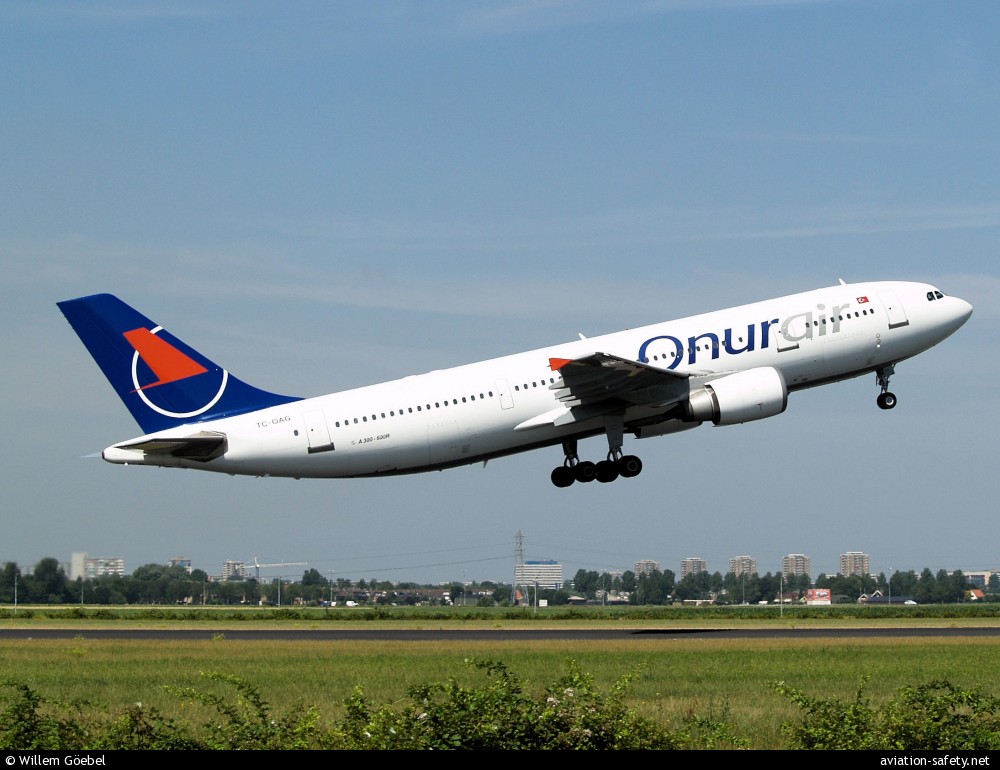
| Date: | Tuesday 1 May 2012 |
| Time: | 14:49 |
| Type: |  Airbus A300B4-605R |
| Owner/operator: | Saudi Arabian Airlines |
| Registration: | TC-OAG |
| MSN: | 747 |
| Year of manufacture: | 1994 |
| Total airframe hrs: | 54832 hours |
| Cycles: | 18308 flights |
| Engine model: | General Electric CF6-80C2A5 |
| Fatalities: | Fatalities: 0 / Occupants: 10 |
| Aircraft damage: | Substantial, written off |
| Category: | Accident |
| Location: | Jeddah-King Abdulaziz International Airport (JED) -
 Saudi Arabia Saudi Arabia
|
| Phase: | Landing |
| Nature: | Ferry/positioning |
| Departure airport: | Madinah-Mohammad Bin Abdulaziz Airport (MED/OEMA) |
| Jeddah-King Abdulaziz International Airport (JED/OEJN) | |
| Confidence Rating: |
An Airbus A300B4-605R, TC-OAG, sustained damage in a nosegear-up landing at Jeddah International Airport (JED), Saudi Arabia. There were no injuries.
The airplane operated on a ferry flight from Madina (MED), Saudi Arabia carrying ten crew members.
The visibility at Jeddah was good with a few clouds present. During the initial ILS approach to runway 16R, while at 8 nautical miles and 2600 feet, the landing gear handle was lowered. Both main landing gears extended and locked down and, the nose gear doors opened but the nose landing gear did not lower. The captain who was then the Pilot Monitoring (PM) took over the controls and carried out a missed approach.
The First Officer (FO) became the Pilot Monitoring (PM). SVA 2865 was then given an area to the northeast of Jeddah to carry out attempts at lowering the nose gear.
The flight crew attempted to manually free fall the nose landing gear at least ten times. The nose landing gear would not lower into the locked position, but the nose gear doors remained open during all those attempts.
As a precautionary measure, SVA 2865 performed a fly-by of runway 16R at 500 ft. The air traffic controller confirmed that the nose landing gear was not down.
SVA 2865 was vectored over the Red Sea to lower the fuel load, thus reducing the landing weight. During this period, the Fire & Rescue Services (FRS) at Jeddah foamed a portion of runway 16L between taxiway Kilo 5 (K5) and K2.
SVA 2865 was vectored for an instrument approach for runway 16L. The Auto Pilot and the Auto Throttle Systems were OFF. The surface winds were from 220° at 12 knots (kt), gusting to 19 kt and the temperature was +37 Celsius (°C).
The flight crew used the "Landing with Nose Landing Gear Abnormal" checklist ensuring the aircraft was properly prepared and configured for the approach, the before landing, the flare and the touchdown sequences, including when the aircraft stopped and the necessary procedures to secure the aircraft before evacuation.
The aircraft landed on its main landing gear 4000 ft past the threshold of runway 16L. The nose of the aircraft was slowly lowered to the runway with the nose landing gear doors touching the runway within the foamed area 4500 ft from the end of runway 16L. The front of the fuselage then touched the runway within the last portion of foam, 3500 ft from the end of runway 16L. The nose area of the aircraft slid on the runway, where sparks were present until the aircraft came to a full stop 1500 ft prior to the end of runway 16L. There was no fire.
Cause Related Findings:
1. The NLG up-lock contained a spring, Part Number GA71102 that was broken as a result of fatigue initiated at the third coil of the spring.
2. The spring had been broken for a prolonged period of time, as noted by the spring linear wear marks on the outside area of the spring coils.
3. Damage observed on the NLG up-lock resulted from hard contact with the broken spring during normal NLG operation.
4. The fracture process of the spring was initiated at the third coil level. At least 6000 cycles of fatigue (number of striations) have been estimated by fatigue striation measurements. The crack on the spring started on the internal surface of the spring which was not shot peened.
5. The normal and free fall extensions of the NLG failed due to a mechanical blockage created by the broken spring jammed against the cam.
Sources:
Report AIB-2013-0002
History of this aircraft
Other occurrences involving this aircraft
| 17 April 2012 | TC-OAG | Onur Air | 1 | Amman-Queen Alia International Airport (AMM/OJAI) |  |
non |
Location
Images:

photo (c) Werner Fischdick; Amsterdam-Schiphol International Airport (AMS/EHAM); 03 May 2008

photo (c) Timo Blossfeld; Amsterdam-Schiphol International Airport (AMS/EHAM); 11 August 2007

photo (c) Willem Göebel; Amsterdam-Schiphol International Airport (AMS/EHAM)
Revision history:
| Date/time | Contributor | Updates |
|---|
The Aviation Safety Network is an exclusive service provided by:


 ©2024 Flight Safety Foundation
©2024 Flight Safety Foundation